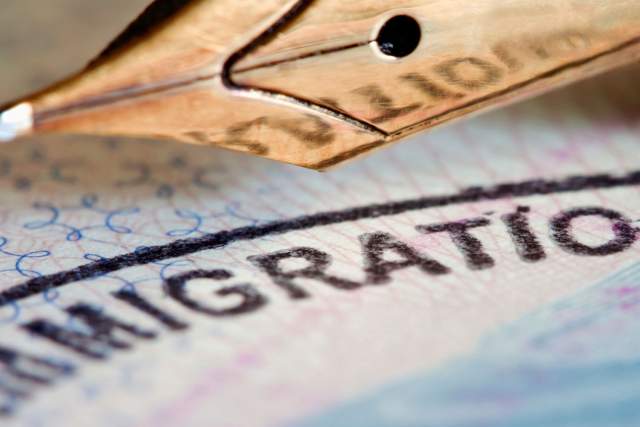Spring is often a season of joyous change. But here in America, spring also ends up being a time of anxious change for hundreds of thousands of highly educated foreigners as they await the results of a potentially life-changing lottery. This is the lottery run by the U.S. Citizenship and Immigration Services for H-1B work visas.
An H-1B visa allows a company to create a new job for a highly educated foreigner in the United States for three to six years. The H-1B program, which accounts for how most of America’s skilled immigrants first enter the workforce, imposes an annual cap of 85,000 new visas: 65,000 with at least a bachelor’s degree and 20,000 with at least a master’s degree.
Since the mid-1990s, almost every year demand for new H-1B visas has far exceeded this capped supply. In those years, USCIS has conducted a random lottery to allocate the new visas. Yesterday afternoon, USCIS posted a news release stating that for fiscal year 2022, yet again demand exceeded supply—and so yet again a lottery had to be held.
We two Matts are crossing fingers for any and all Tuck graduates who were in this year’s H-1B lottery. And in this missive, we want to underscore how unnecessarily costly America’s too-restrictive skilled-immigration policy is.
There is a real, tangible cost to the U.S. economy of allocating fewer skilled-immigrant visas than what companies need. Most immediately, the cost is forgone jobs created in the sponsoring companies. The H-1B process forces companies to scramble to make alternative plans when the vagaries of chance deny them desired visas. Companies that cannot hire talented immigrants in America often don’t hire anyone at all. Or these companies do hire—but outside America, because they cannot hire enough talent in America alone.
There is a real, tangible cost to the U.S. economy of allocating fewer skilled-immigrant visas than what companies need. Most immediately, the cost is forgone jobs created in the sponsoring companies.
More broadly, the cost is forgone ideas, innovation, and connections to the world—all of which drive overall U.S. economic performance. The too-low cap on H-1B visas constrains the nation’s capacity to innovate. Immigrants have long made substantial contributions to American innovation, both at the highest levels and throughout the economy at all stages of discovering and developing new ideas. The contribution of immigrants to American talent and creativity has perhaps been most visible at the pinnacles of success. Among the truly outstanding in several fields—such as academics, entrepreneurship, the arts, and athletics—immigrants are significantly overrepresented, compared with their presence in the overall U.S. population or labor force.
Immigrants are only about 14 percent of all U.S. residents today. Yet a study a few years ago found that immigrants are about 36 percent of U.S.-resident Nobel Prize winners in chemistry, medicine, and physics over the past 20 years; 31 percent of all U.S.-resident Nobel winners during that time; and 22 percent of all U.S.-based MacArthur Foundation “genius award” winners since 2000.
This outsized presence of immigrants in America’s upper reaches of talent similarly applies in the realm of business. One recent study found that immigrants accounted for 25 percent of all new high-technology companies from 2006 through 2012, with $63 billion in sales. Immigrants or their children founded 41 percent of the Fortune 500 companies in 2016. Another study found that across all U.S. industries, the immigrant share of all U.S. entrepreneurs rose from 16.7 percent in 1995 to 27.1 percent by 2008. Among all new firms created during this time, over one-third (37.1 percent) had at least one founder who was an immigrant.
The too-low cap on H-1B visas also constrains America’s capacity to create jobs and raise wages for native-born workers. Contrary to the often-heard concern that immigrants are displacing U.S.-born workers, some of the most recent and most innovative studies show the exact opposite: that high-skilled foreign-born workers complement, rather than substitute for, U.S.-born workers. The innovative dynamism of talented immigrants doesn’t crowd out opportunities. It creates them.
High-skilled foreign-born workers complement, rather than substitute for, U.S.-born workers. The innovative dynamism of talented immigrants doesn’t crowd out opportunities. It creates them.
Start with jobs. One of the most ambitious studies linked employee records to their companies for all private-sector firms in 29 states; from that starting point, it tracked the largest, most innovative companies in America from 1995 through 2008 (these accounted for 34 percent of all U.S. patenting during this period). Able to track the hiring of immigrants versus natives, this study estimated that a 10 percent increase in a firm’s employment of skilled immigrants correlated with a 6 percent increase in the total skilled workforce of the firm—with expansion “evident and mostly balanced for older and younger native skilled workers.” Companies that hire more skilled immigrants tend to hire more native-born workers overall as well.
Not only do the labor-market gains of high-talent immigration show up in greater employment, they also show up in higher wages—not just for immigrants themselves but for native-born workers as well. A recent study of 219 U.S. metropolitan areas from 1990 to 2010 found that growth of skilled-immigrant workers by one percentage point of a metro area’s total employment boosted the wages of its native-born college graduates by 7 to 8 percentage points—and of its native-born non-college-educated workers by 3 to 4 percentage points. More skilled immigrants tend to boost wages of all native-born Americans—thanks to innovation and productivity growth. Indeed, this study estimated that U.S. inflows of skilled immigrants accounted for somewhere between 30 percent and fully 50 percent of U.S.-wide growth in productivity over this 1990–2010 period.
And as costly as America’s current policies are toward high-skilled immigration when seen in isolation, they look even more costly when seen relative to other countries. The world’s talented people do not consider just their birth country or America when contemplating home. The entire world beckons, and many other countries are welcoming talent far more sensibly and aggressively than does the United States.
We see this very clearly in the business-school world. On the cusp of the pandemic in October 2019, the Graduate Management Admission Council released a new report documenting that the world’s talent was increasingly looking for education and work opportunities beyond America. In 2019, the United States experienced a 13.7 percent decline in international business-school applications. This drop came amidst stable or rising applications almost everywhere else in the world. Just north in Canada, for example, international business-school applications rose 16.4 percent in 2018 and again 8.6 percent in 2019.
The world’s talented people do not consider just their birth country or America when contemplating home. The entire world beckons, and many other countries are welcoming talent far more sensibly and aggressively than does the United States.
At least part of what was driving this shift in applications was the waning attractiveness of America in the eyes of foreign business students. The share of global applicants who cite the United States as their preferred destination slid from 54 percent in 2009 to just 37 percent in the first half of 2019. Preference for Europe had surpassed America, growing from 31 percent in 2016 to 38 percent in the first half of 2019.
Why are international students looking beyond America for business education? It does not seem to be because of general economic uncertainty. Consider the United Kingdom. Despite all the Brexit turmoil, in 2019 fully 61 percent of U.K. programs reported an increase in international applications, and the share of Graduate Management Admission Test score reports sent to U.K. programs had risen since 2016. Indeed, in December 2018, 54 percent of GMAT takers said that Brexit had no impact on the academic attractiveness of Britain.
How could this be? More important to global students than general economic conditions are policies related to their postgraduation employability. In recent years, the U.K. has taken several policy steps to expand international students’ work prospects there. Most recently, Prime Minister Boris Johnson announced a new plan under which eligible international students can work and/or seek employment for two years after graduation—with no cap on the number of these visas.
That brings us back to the United States. In Washington, DC, these days there is much talk of “going big” on economic policy. The $1.9 trillion American Rescue Plan Act aims to boost short-run aggregate demand and thus output and employment. But for America’s longer-term economic health, allocating too few skilled-immigrant visas costs America forgone innovation that is the foundation of sustainable growth in output, jobs, and incomes. It is high time for America to go big on skilled-immigration policy.

